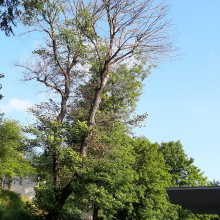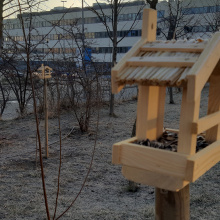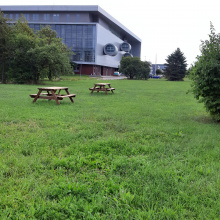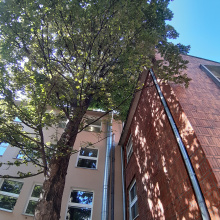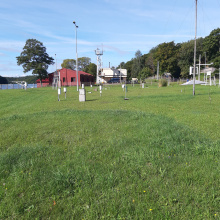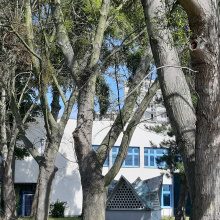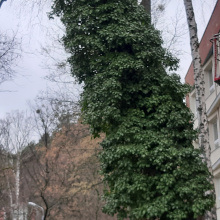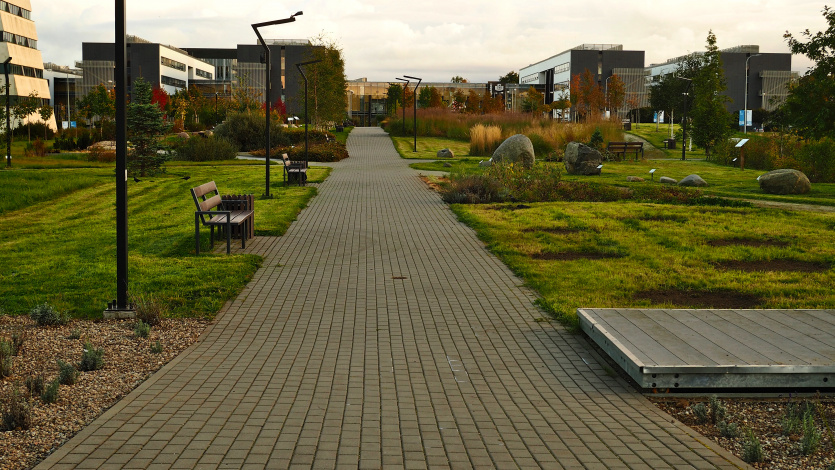
The development of the University of Gdańsk campus over the past 20 years has not only involved new faculties. Construction investments at our University have gone hand in hand with environmental projects. New trees, ponds, lawns and even beehives. We talk about what exactly has changed and what the future of green areas will look like with Alina Szlachetko, coordinator for green areas at the UG.
Marcel Jakubowski: - What does the term 'UG green areas' mean? Is it only the Maciej Płażyński Park?
Alina Szlachetko: - The UG's green areas are not only the Eco-Park and the lawns of the Oliwa Campus, but also the forest areas in Łączyn in Kashubia, the dendrological garden in Sobieszewo, and the dune areas on the Hel Peninsula. At our university, flora can be found on eleven campuses, including those in Sopot, Gdynia, Gdańsk - Oliwa, ul. Kładki, Bielańska, Brzeźno, and Borzęcin.
I take care of the green areas on all UG campuses except for Eko-Park, which from the beginning has been taken care of by the planting company. On behalf of the University of Gdańsk, the park is looked after by dr Krzysztof Gos and Mr Jan Wróbel.
- What are your daily duties?
- I started my work by taking stock of the trees, showing how they are distributed and determining their health status. I visited all the campuses, looked at the problems that affect the greenery there, and documented the characteristic elements in different seasons. About 5,000 photos came out of it.
After each visit, I wrote reports and recommendations, which I presented to the University authorities. The problems are many. I started with the ones that pose a threat, such as trees that have been dead for years and are rotten. I prepared the documentation so that the Environment Office would issue a decision to cut them down. This is not a satisfying moment of work. I try to make sure that when they are cut down, the 'witnesses' of times gone by remain.
The next stage was meetings with the deans and administration of the various faculties. These discussions resulted in a calendar of gardening work on campus. Together we planned the planting of various species of trees and shrubs. I handed the calendar over to the chancellor's authorities in mid-December. The implementation of the planned activities started in January. Of course, things don't always go as we wish. We are implementing the plan while waiting for the gardening team. The pruning of bushes and trees was carried out in January and February. This procedure is essential for the crown formation and stimulates plant growth. I have been at every branch cutting to give the tree the right shape, or at least to give direction for the three-year crown formation process.
On the left tree after pruning, on the right tree
with a shaped crown
Some trees, such as the hawthorns at WPiA, had never had their crowns formed, they were statically disturbed, so we tried to verticalize them.
My activity also includes looking for sponsors for green corners. Talks with the developer of a large construction company may bear fruit. I planned to plant about 400 trees and shrubs in different parts of the Oliwa campus, but I didn't realise the limitations posed by the dense network of utilities running under the surface of the ground.
Greenery is not only trees, it's also lawns, various kinds of flowery meadows, which together constitute 7.8 hectares, not counting the area of the Eco-Park. Thinking ecologically about the environment, I have tried to reduce the frequency of grass cutting. The largest area of the Oliwa Campus will be mown twice in the growing season, the centre of the Campus once a month. I have designated areas, so-called 'flower meadows', which will be mowed once a year.
In March, common plants such as poppies, bellflowers, chamomile, starthistles and chicory are sown in the flower meadows. I collect the seeds of these species in the autumn in the meadows. By the car parks, grasslands have developed on the sand islands, which will also only be mown once a season. Flower meadows and grasslands are home to many insects, attracting them with their attractive scent and rich colours. We plan to place several insect houses. In winter, we will place several feeders in the Eco-Park in case there is a lack of fruit and seeds for visitors from far away.
Hawthorns at the Faculty of Law and Administration
March is also the time for planting trees and shrubs, reseeding flower meadows, first mowing with verticulation and aeration, feeding the lawns with mineral fertilisers and first spraying.
- Do you also take care of the beehives in ul. Bażyńskiego?
- The bees are looked after by a beekeeper contracted by the Municipal Office. However, I visit the hives from time to time. In January I noticed that some bees were leaving the hive and I suggested feeding them.
- What did the UG green areas look like 20 years ago? What has changed?
- I can still remember the image of the campus from the 1980s. The Oliwa campus consisted of three buildings: The Rector's Office, the Faculty of Philology and History, and the Faculty of Mathematics and Physics, surrounded by allotment gardens, of which old apple and plum trees remain to this day. Students of the Faculty of Biology and Earth Sciences had classes in Gdańsk, Sopot and Gdynia. It often happened that they were in these three, yet quite distant places on the same day. You ask, what has changed? Everything has changed unimaginably. The students have excellent conditions for learning and recreation, but more can always be done.
- If you had no financial constraints, what would you do?
- The modern architecture of the campus buildings also dictates the style of the green spaces. I dream of a vast space with trees and shrubs dancing in the sun, where the academic community can find secluded corners, places to relax and socialise. In the centre of the Campus, in the surroundings of the Library, I would plan comfortable benches blending in with the buildings in a modern style. In this centre, in spaces with a touch of mystery, I would place brass stylised small figures of students, for example reading a book, sitting at a computer, looking at the world under a magnifying glass, holding a globe, abacus, test tubes, etc. Wrocław has its dwarfs, we can have our student figures.
There aren't enough trees on campus. We need to plant a lot of attractive varieties that create interesting spatial forms to break up this huge space, create friendly nooks by planting tall, ribbon-shaped hedges. By planting new varieties of trees, mini-parks can be organised in the vast space facing ul. Wita Stwosza. In one of them a small playground with a 'monkey grove' and a treehouse for the children of our students and employees. In another place, a fitness park, where students could work on their fitness lost due to winter sitting.
I would also like to see a few rain gardens, which would be crossed by babbling brooks. It would be nice to spend time in such a place, especially considering its specific microclimate. Water gardens would look attractive e.g. in patios of buildings. I have already proposed such a garden at the Faculty of Philology and History. It is also possible to organise green spaces on roofs, intimate places for relaxation and sunbathing.
- What is the greatest threat to the greenery of the UG? Tree diseases or people?
On the left a maple infested with mistletoe, on the right the same tree without the semi-parasite
- Many of the plants that make up these green spaces are in poor condition, diseased, e.g. yellowing spruces attacked by the bollworm larva, boxwoods by the boxwood moth. Pitting on the laurel leaves is a sign of Otiorhynchus feeding. In spring, aphids appear on many trees, black spots on the leaves are a symptom of viral diseases, grey spots are fungi, etc. Mistletoe, a semi-parasite, likes to take up residence on maple trees. Sucking water and mineral salts from the tree weakens it considerably and eventually leads to its death.
Of course, various plant protection products can be used in the garden, but in such a large area, where people are constantly present, it's very difficult to apply sprays, although we try to help some, such as the spruce near the Faculty of Law and Administration.
Unfortunately, some of the plants are dying, they look unattractive, so by applying sanitary cuts and shrubs pruning we strengthen them and provoke them to put out young twigs.
People are not blameless either. They trample the lawns, trample the hedges making 'shortcuts' for themselves, this does not add beauty to the green space.
- What is the state of the UG greenery? Do you still have a lot of work ahead of you?
- Although there is no shortage of charming places on campus, the vegetation we are currently nurturing is only the beginning of the road to an attractive green space. There is a lot of work to be done on the campuses. Green gardens and parks are endless work at any time of the year, but very fascinating.
- Thank you for the interview.

